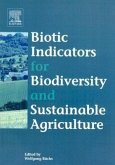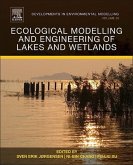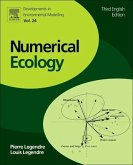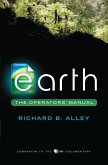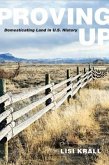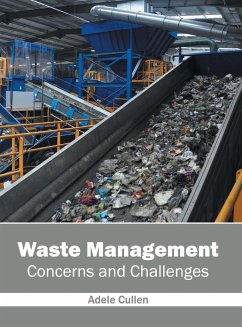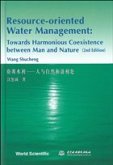Perspectives for Agroecosystem Management:
Balancing Environmental and Socio-Economic Demands
Herausgeber: Schroder, Peter; Munch, J.; Pfadenhauer, J.
Perspectives for Agroecosystem Management:
Balancing Environmental and Socio-Economic Demands
Herausgeber: Schroder, Peter; Munch, J.; Pfadenhauer, J.
- Gebundenes Buch
- Merkliste
- Auf die Merkliste
- Bewerten Bewerten
- Teilen
- Produkt teilen
- Produkterinnerung
- Produkterinnerung
Sustainable agriculture is a key concept for scientists, researchers, and agricultural engineers alike. This book focuses on the FAM- project (FAM Munich Research Network on Agroecosystems) of the 1990s as a means to assessing, forecasting, and evaluating changes in the agroecosystems that are necessary for agricultural sustainability. The management of two separate management systems: an organic and an integrated farming system are described to provide an interdisciplinary approach Changes of matter fluxes in soils, changes of trace gas fluxes from soils, precision farming in a small scale…mehr
Andere Kunden interessierten sich auch für
![Biotic Indicators for Biodiversity and Sustainable Agriculture Biotic Indicators for Biodiversity and Sustainable Agriculture]() W. BuchsBiotic Indicators for Biodiversity and Sustainable Agriculture331,99 €
W. BuchsBiotic Indicators for Biodiversity and Sustainable Agriculture331,99 €![Ecological Modelling and Engineering of Lakes and Wetlands Ecological Modelling and Engineering of Lakes and Wetlands]() Ecological Modelling and Engineering of Lakes and Wetlands147,99 €
Ecological Modelling and Engineering of Lakes and Wetlands147,99 €![Numerical Ecology Numerical Ecology]() Pierre LegendreNumerical Ecology102,50 €
Pierre LegendreNumerical Ecology102,50 €![Earth: The Operators' Manual Earth: The Operators' Manual]() Richard B. AlleyEarth: The Operators' Manual25,99 €
Richard B. AlleyEarth: The Operators' Manual25,99 €![Proving Up Proving Up]() Lisi KrallProving Up113,99 €
Lisi KrallProving Up113,99 €![Waste Management: Concerns and Challenges Waste Management: Concerns and Challenges]() Waste Management: Concerns and Challenges135,99 €
Waste Management: Concerns and Challenges135,99 €![Resource-Oriented Water Management: Towards Harmonious Coexistence Between Man and Nature (2nd Edition) Resource-Oriented Water Management: Towards Harmonious Coexistence Between Man and Nature (2nd Edition)]() Wang ShuchengResource-Oriented Water Management: Towards Harmonious Coexistence Between Man and Nature (2nd Edition)105,99 €
Wang ShuchengResource-Oriented Water Management: Towards Harmonious Coexistence Between Man and Nature (2nd Edition)105,99 €-
-
-
Sustainable agriculture is a key concept for scientists, researchers, and agricultural engineers alike. This book focuses on the FAM- project (FAM Munich Research Network on Agroecosystems) of the 1990s as a means to assessing, forecasting, and evaluating changes in the agroecosystems that are necessary for agricultural sustainability. The management of two separate management systems: an organic and an integrated farming system are described to provide an interdisciplinary approach Changes of matter fluxes in soils, changes of trace gas fluxes from soils, precision farming in a small scale heterogen landscape, influence of management changes on flora and fauna, as well as the development of agroecosystem models, the assessment of soil variability and the changes in nutrient status are important aspects of this book.
Hinweis: Dieser Artikel kann nur an eine deutsche Lieferadresse ausgeliefert werden.
Hinweis: Dieser Artikel kann nur an eine deutsche Lieferadresse ausgeliefert werden.
Produktdetails
- Produktdetails
- Verlag: Elsevier Science
- Seitenzahl: 456
- Erscheinungstermin: 1. Januar 2008
- Englisch
- Abmessung: 242mm x 180mm x 24mm
- Gewicht: 966g
- ISBN-13: 9780444519054
- ISBN-10: 044451905X
- Artikelnr.: 23131498
- Herstellerkennzeichnung
- Libri GmbH
- Europaallee 1
- 36244 Bad Hersfeld
- gpsr@libri.de
- Verlag: Elsevier Science
- Seitenzahl: 456
- Erscheinungstermin: 1. Januar 2008
- Englisch
- Abmessung: 242mm x 180mm x 24mm
- Gewicht: 966g
- ISBN-13: 9780444519054
- ISBN-10: 044451905X
- Artikelnr.: 23131498
- Herstellerkennzeichnung
- Libri GmbH
- Europaallee 1
- 36244 Bad Hersfeld
- gpsr@libri.de
List of Contributors
Preface
Part I: Approaching Sustainable Agriculture
1.1 Outline of the Scheyern Project
1.1.1 Background
1.1.2 Research Station and Project Phases
1.1.3 Two Farming Systems
1.2 Sustainable Land Use by Organic and Integrated Farming Systems
1.2.1 Organic Farming System in Scheyern
1.2.2 Integrated Farming System in Scheyern
1.2.3 Discussion
Part II: Management of Heterogeneous Systems
2.1 Effects of the Management System on N-, C-, P- and K-Fluxes from FAM
Soils
2.1.1 Introduction
2.1.2 Materials and Methods
2.1.3 Results
2.1.4 Conclusions
2.2 Main Driving Variables and Effect of Soil Management on Climate or
Ecosystem-Relevant Trace Gas Fluxes from Fields of the FAM
2.2.1 Production and Consumption of the Climaterelevant Trace Gases Nitrous
Oxide and Methane in Soils
2.2.2 Important Controlling Factors for N2O Fluxes at the FAM Sites
2.2.3 Important Controlling Factors for CH4 Fluxes Mat The FAM Sites
2.2.4 Ammonia Emissions from Agricultural Land Use
2.3 Precision Farming - Adaptation of Land Use Management to Small Scale
Heterogeneity
2.3.1 Basics and Objective
2.3.2 Development of Methods to Characterize Spatial Variability of Soils,
Crops, and Yield
2.3.3 Development of Site-Specific Crop Production Strategies
2.3.4 Conclusions
Part III: Influence of Land Use Changes on the Biotic Environment
3.1 Effects of Land Use Changes on the Plant Species Diversity in
Agricultural Ecosystems
3.1.1 Introduction
3.1.2 Land Use Systems Practised in the Research Area
3.1.3 Vegetation Analysis
3.1.4 Results
3.1.5 Discussion
3.1.6 Conclusions
3.2 Long-Term Effects of Reduced Tillage on the Populations of Arable Weeds
3.2.1 Introduction
3.2.2 Research Area and Management
3.2.3 Materials and Methods
3.2.4 Results and Discussion
3.2.5 Conclusions
3.3 Dispersal Strategies: Are They Responsible for Species Success in
Arable Ecosystems?
3.3.1 Introduction
3.3.2 Specific Ways of Dispersal in Arable Ecosystems
3.3.3 Dispersal by Human Activity - a Dispersal Strategy or a Random
Process?
3.3.4 Dispersal Opportunity and Species Success
3.3.5 Cirsium Arvense and Veronica Triphyllos - a Successful and a Stagnant
Species
3.3.6 Conclusions
3.4 Soil Microbial Communities and Related Functions
3.4.1 Introduction
3.4.2 Materials and Methods
3.4.3 Singular Environmental and Anthropogenic Effects
3.4.4 Effect of Land Use and Farming Systems
3.4.5 Precision Farming: Site-Specific Fertilization
3.5 Mesofauna
3.5.1 Introduction
3.5.2 Occurrence and Distribution of Mesofauna
3.5.3 Indicator Value
3.5.4 Collembola and their Influence on Microbial Diversity
3.5.5 Perspective
3.6 Spiders (Araneae) in Arable Land: Species Community, Influence of Land
Use on Diversity, and Biocontrol Significance
3.6.1 Introduction
3.6.2 The Community of Foliage-Dwelling Spiders in Arable Land
3.6.3 The Influence of Land Use on Foliage-Dwelling Spiders in Field
Margins
3.6.4 Biocontrol Significance of Spiders
3.6.5 Concluding Remarks
Part IV: Influence of the Land Use Changes on the Abiotic Environment
4.1 Development and Application of Agro-Ecosystem Models
4.1.1 Introduction
4.1.2 Modular Model Development
4.1.3 Retrospective Modeling of Soil Water Flow
4.1.5 Crop Growth Modeling
4.1.4 Simulation of Organic Matter Turnover and Nitrate Leaching
4.1.6 assessment of Nitrous Oxide Emissions
4.1.7 Conclusions
4.2 Assessment of Soil Landscape Variability
4.2.1 Introduction
4.2.2 Terrain Analysis
4.2.3 Electromagnetic Induction
4.2.4 Remote Sensing
4.2.5 Conclusions
4.3 Changes in Nutrient Status on the Experimental Station Klostergut
Scheyern from 1991 to 2001 - Statistical and Geostatistical Analysis
4.3.1 Introduction
4.3.2 Material and Methods
4.3.3 Results
4.3.4 Discussion
Outlook
Index
Color Plate Section
Preface
Part I: Approaching Sustainable Agriculture
1.1 Outline of the Scheyern Project
1.1.1 Background
1.1.2 Research Station and Project Phases
1.1.3 Two Farming Systems
1.2 Sustainable Land Use by Organic and Integrated Farming Systems
1.2.1 Organic Farming System in Scheyern
1.2.2 Integrated Farming System in Scheyern
1.2.3 Discussion
Part II: Management of Heterogeneous Systems
2.1 Effects of the Management System on N-, C-, P- and K-Fluxes from FAM
Soils
2.1.1 Introduction
2.1.2 Materials and Methods
2.1.3 Results
2.1.4 Conclusions
2.2 Main Driving Variables and Effect of Soil Management on Climate or
Ecosystem-Relevant Trace Gas Fluxes from Fields of the FAM
2.2.1 Production and Consumption of the Climaterelevant Trace Gases Nitrous
Oxide and Methane in Soils
2.2.2 Important Controlling Factors for N2O Fluxes at the FAM Sites
2.2.3 Important Controlling Factors for CH4 Fluxes Mat The FAM Sites
2.2.4 Ammonia Emissions from Agricultural Land Use
2.3 Precision Farming - Adaptation of Land Use Management to Small Scale
Heterogeneity
2.3.1 Basics and Objective
2.3.2 Development of Methods to Characterize Spatial Variability of Soils,
Crops, and Yield
2.3.3 Development of Site-Specific Crop Production Strategies
2.3.4 Conclusions
Part III: Influence of Land Use Changes on the Biotic Environment
3.1 Effects of Land Use Changes on the Plant Species Diversity in
Agricultural Ecosystems
3.1.1 Introduction
3.1.2 Land Use Systems Practised in the Research Area
3.1.3 Vegetation Analysis
3.1.4 Results
3.1.5 Discussion
3.1.6 Conclusions
3.2 Long-Term Effects of Reduced Tillage on the Populations of Arable Weeds
3.2.1 Introduction
3.2.2 Research Area and Management
3.2.3 Materials and Methods
3.2.4 Results and Discussion
3.2.5 Conclusions
3.3 Dispersal Strategies: Are They Responsible for Species Success in
Arable Ecosystems?
3.3.1 Introduction
3.3.2 Specific Ways of Dispersal in Arable Ecosystems
3.3.3 Dispersal by Human Activity - a Dispersal Strategy or a Random
Process?
3.3.4 Dispersal Opportunity and Species Success
3.3.5 Cirsium Arvense and Veronica Triphyllos - a Successful and a Stagnant
Species
3.3.6 Conclusions
3.4 Soil Microbial Communities and Related Functions
3.4.1 Introduction
3.4.2 Materials and Methods
3.4.3 Singular Environmental and Anthropogenic Effects
3.4.4 Effect of Land Use and Farming Systems
3.4.5 Precision Farming: Site-Specific Fertilization
3.5 Mesofauna
3.5.1 Introduction
3.5.2 Occurrence and Distribution of Mesofauna
3.5.3 Indicator Value
3.5.4 Collembola and their Influence on Microbial Diversity
3.5.5 Perspective
3.6 Spiders (Araneae) in Arable Land: Species Community, Influence of Land
Use on Diversity, and Biocontrol Significance
3.6.1 Introduction
3.6.2 The Community of Foliage-Dwelling Spiders in Arable Land
3.6.3 The Influence of Land Use on Foliage-Dwelling Spiders in Field
Margins
3.6.4 Biocontrol Significance of Spiders
3.6.5 Concluding Remarks
Part IV: Influence of the Land Use Changes on the Abiotic Environment
4.1 Development and Application of Agro-Ecosystem Models
4.1.1 Introduction
4.1.2 Modular Model Development
4.1.3 Retrospective Modeling of Soil Water Flow
4.1.5 Crop Growth Modeling
4.1.4 Simulation of Organic Matter Turnover and Nitrate Leaching
4.1.6 assessment of Nitrous Oxide Emissions
4.1.7 Conclusions
4.2 Assessment of Soil Landscape Variability
4.2.1 Introduction
4.2.2 Terrain Analysis
4.2.3 Electromagnetic Induction
4.2.4 Remote Sensing
4.2.5 Conclusions
4.3 Changes in Nutrient Status on the Experimental Station Klostergut
Scheyern from 1991 to 2001 - Statistical and Geostatistical Analysis
4.3.1 Introduction
4.3.2 Material and Methods
4.3.3 Results
4.3.4 Discussion
Outlook
Index
Color Plate Section
List of Contributors
Preface
Part I: Approaching Sustainable Agriculture
1.1 Outline of the Scheyern Project
1.1.1 Background
1.1.2 Research Station and Project Phases
1.1.3 Two Farming Systems
1.2 Sustainable Land Use by Organic and Integrated Farming Systems
1.2.1 Organic Farming System in Scheyern
1.2.2 Integrated Farming System in Scheyern
1.2.3 Discussion
Part II: Management of Heterogeneous Systems
2.1 Effects of the Management System on N-, C-, P- and K-Fluxes from FAM
Soils
2.1.1 Introduction
2.1.2 Materials and Methods
2.1.3 Results
2.1.4 Conclusions
2.2 Main Driving Variables and Effect of Soil Management on Climate or
Ecosystem-Relevant Trace Gas Fluxes from Fields of the FAM
2.2.1 Production and Consumption of the Climaterelevant Trace Gases Nitrous
Oxide and Methane in Soils
2.2.2 Important Controlling Factors for N2O Fluxes at the FAM Sites
2.2.3 Important Controlling Factors for CH4 Fluxes Mat The FAM Sites
2.2.4 Ammonia Emissions from Agricultural Land Use
2.3 Precision Farming - Adaptation of Land Use Management to Small Scale
Heterogeneity
2.3.1 Basics and Objective
2.3.2 Development of Methods to Characterize Spatial Variability of Soils,
Crops, and Yield
2.3.3 Development of Site-Specific Crop Production Strategies
2.3.4 Conclusions
Part III: Influence of Land Use Changes on the Biotic Environment
3.1 Effects of Land Use Changes on the Plant Species Diversity in
Agricultural Ecosystems
3.1.1 Introduction
3.1.2 Land Use Systems Practised in the Research Area
3.1.3 Vegetation Analysis
3.1.4 Results
3.1.5 Discussion
3.1.6 Conclusions
3.2 Long-Term Effects of Reduced Tillage on the Populations of Arable Weeds
3.2.1 Introduction
3.2.2 Research Area and Management
3.2.3 Materials and Methods
3.2.4 Results and Discussion
3.2.5 Conclusions
3.3 Dispersal Strategies: Are They Responsible for Species Success in
Arable Ecosystems?
3.3.1 Introduction
3.3.2 Specific Ways of Dispersal in Arable Ecosystems
3.3.3 Dispersal by Human Activity - a Dispersal Strategy or a Random
Process?
3.3.4 Dispersal Opportunity and Species Success
3.3.5 Cirsium Arvense and Veronica Triphyllos - a Successful and a Stagnant
Species
3.3.6 Conclusions
3.4 Soil Microbial Communities and Related Functions
3.4.1 Introduction
3.4.2 Materials and Methods
3.4.3 Singular Environmental and Anthropogenic Effects
3.4.4 Effect of Land Use and Farming Systems
3.4.5 Precision Farming: Site-Specific Fertilization
3.5 Mesofauna
3.5.1 Introduction
3.5.2 Occurrence and Distribution of Mesofauna
3.5.3 Indicator Value
3.5.4 Collembola and their Influence on Microbial Diversity
3.5.5 Perspective
3.6 Spiders (Araneae) in Arable Land: Species Community, Influence of Land
Use on Diversity, and Biocontrol Significance
3.6.1 Introduction
3.6.2 The Community of Foliage-Dwelling Spiders in Arable Land
3.6.3 The Influence of Land Use on Foliage-Dwelling Spiders in Field
Margins
3.6.4 Biocontrol Significance of Spiders
3.6.5 Concluding Remarks
Part IV: Influence of the Land Use Changes on the Abiotic Environment
4.1 Development and Application of Agro-Ecosystem Models
4.1.1 Introduction
4.1.2 Modular Model Development
4.1.3 Retrospective Modeling of Soil Water Flow
4.1.5 Crop Growth Modeling
4.1.4 Simulation of Organic Matter Turnover and Nitrate Leaching
4.1.6 assessment of Nitrous Oxide Emissions
4.1.7 Conclusions
4.2 Assessment of Soil Landscape Variability
4.2.1 Introduction
4.2.2 Terrain Analysis
4.2.3 Electromagnetic Induction
4.2.4 Remote Sensing
4.2.5 Conclusions
4.3 Changes in Nutrient Status on the Experimental Station Klostergut
Scheyern from 1991 to 2001 - Statistical and Geostatistical Analysis
4.3.1 Introduction
4.3.2 Material and Methods
4.3.3 Results
4.3.4 Discussion
Outlook
Index
Color Plate Section
Preface
Part I: Approaching Sustainable Agriculture
1.1 Outline of the Scheyern Project
1.1.1 Background
1.1.2 Research Station and Project Phases
1.1.3 Two Farming Systems
1.2 Sustainable Land Use by Organic and Integrated Farming Systems
1.2.1 Organic Farming System in Scheyern
1.2.2 Integrated Farming System in Scheyern
1.2.3 Discussion
Part II: Management of Heterogeneous Systems
2.1 Effects of the Management System on N-, C-, P- and K-Fluxes from FAM
Soils
2.1.1 Introduction
2.1.2 Materials and Methods
2.1.3 Results
2.1.4 Conclusions
2.2 Main Driving Variables and Effect of Soil Management on Climate or
Ecosystem-Relevant Trace Gas Fluxes from Fields of the FAM
2.2.1 Production and Consumption of the Climaterelevant Trace Gases Nitrous
Oxide and Methane in Soils
2.2.2 Important Controlling Factors for N2O Fluxes at the FAM Sites
2.2.3 Important Controlling Factors for CH4 Fluxes Mat The FAM Sites
2.2.4 Ammonia Emissions from Agricultural Land Use
2.3 Precision Farming - Adaptation of Land Use Management to Small Scale
Heterogeneity
2.3.1 Basics and Objective
2.3.2 Development of Methods to Characterize Spatial Variability of Soils,
Crops, and Yield
2.3.3 Development of Site-Specific Crop Production Strategies
2.3.4 Conclusions
Part III: Influence of Land Use Changes on the Biotic Environment
3.1 Effects of Land Use Changes on the Plant Species Diversity in
Agricultural Ecosystems
3.1.1 Introduction
3.1.2 Land Use Systems Practised in the Research Area
3.1.3 Vegetation Analysis
3.1.4 Results
3.1.5 Discussion
3.1.6 Conclusions
3.2 Long-Term Effects of Reduced Tillage on the Populations of Arable Weeds
3.2.1 Introduction
3.2.2 Research Area and Management
3.2.3 Materials and Methods
3.2.4 Results and Discussion
3.2.5 Conclusions
3.3 Dispersal Strategies: Are They Responsible for Species Success in
Arable Ecosystems?
3.3.1 Introduction
3.3.2 Specific Ways of Dispersal in Arable Ecosystems
3.3.3 Dispersal by Human Activity - a Dispersal Strategy or a Random
Process?
3.3.4 Dispersal Opportunity and Species Success
3.3.5 Cirsium Arvense and Veronica Triphyllos - a Successful and a Stagnant
Species
3.3.6 Conclusions
3.4 Soil Microbial Communities and Related Functions
3.4.1 Introduction
3.4.2 Materials and Methods
3.4.3 Singular Environmental and Anthropogenic Effects
3.4.4 Effect of Land Use and Farming Systems
3.4.5 Precision Farming: Site-Specific Fertilization
3.5 Mesofauna
3.5.1 Introduction
3.5.2 Occurrence and Distribution of Mesofauna
3.5.3 Indicator Value
3.5.4 Collembola and their Influence on Microbial Diversity
3.5.5 Perspective
3.6 Spiders (Araneae) in Arable Land: Species Community, Influence of Land
Use on Diversity, and Biocontrol Significance
3.6.1 Introduction
3.6.2 The Community of Foliage-Dwelling Spiders in Arable Land
3.6.3 The Influence of Land Use on Foliage-Dwelling Spiders in Field
Margins
3.6.4 Biocontrol Significance of Spiders
3.6.5 Concluding Remarks
Part IV: Influence of the Land Use Changes on the Abiotic Environment
4.1 Development and Application of Agro-Ecosystem Models
4.1.1 Introduction
4.1.2 Modular Model Development
4.1.3 Retrospective Modeling of Soil Water Flow
4.1.5 Crop Growth Modeling
4.1.4 Simulation of Organic Matter Turnover and Nitrate Leaching
4.1.6 assessment of Nitrous Oxide Emissions
4.1.7 Conclusions
4.2 Assessment of Soil Landscape Variability
4.2.1 Introduction
4.2.2 Terrain Analysis
4.2.3 Electromagnetic Induction
4.2.4 Remote Sensing
4.2.5 Conclusions
4.3 Changes in Nutrient Status on the Experimental Station Klostergut
Scheyern from 1991 to 2001 - Statistical and Geostatistical Analysis
4.3.1 Introduction
4.3.2 Material and Methods
4.3.3 Results
4.3.4 Discussion
Outlook
Index
Color Plate Section


